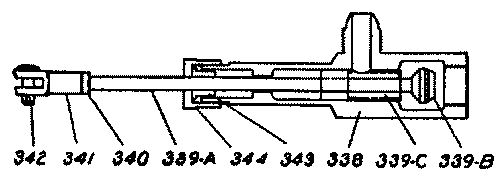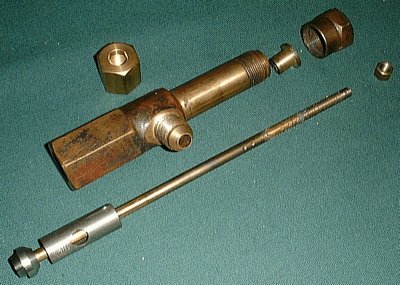|
The major parts of the throttle are
the throttle body (338), and the throttle stem (339-A, B, C). When
closed, a valve disk (339-B) is seated against the throttle body (338).
As you move the throttle lever on the steering column to open the throttle a
mechanical linkage causes the throttle stem assembly to move (towards the
left in the drawing). As that happens the valve disk (339-B) unseats
from the throttle body (338). Once unseated steam is admitted to the
inside of the throttle cylinder (339-C). This cylinder has a hole in
the side of it that aligns with the port in the side of the throttle body
(338).

Even though the valve disk (339-B) is
admitting steam to the throttle, it can not yet leave the throttle because
the hole in the side of the cylinder (339-C) is not yet in align with the
opening in the side of the throttle body (338). This action allows an
equal amount of steam pressure to be on both sides of the valve disk (339-B)
and thus with no pressure differential on the disk it stays were it is
positioned. This is why the throttle is called "balanced". It
won't move on its own once steam starts flowing past the valve disk.
When the throttle is fully closed there is still a little bit of leakage
past the seat of the valve disk and the throttle body but that steam is
trapped inside the cylinder (since the hole in the cylinder is not aligned
with the hole in the throttle body) and can't escape and thus the pressures
on either side of the throttle disk are still equal.
As the throttle is opened more, the
hole in the cylinder (339-C) starts to align with the hole in the side of
the throttle body (338). As this movement occurs a very small segment
of the hole in the throttle cylinder (339-C) overlaps the hole in the
throttle body (338). Steam can then escape from the inside of the
throttle cylinder (339-C) through the hole and out the port on the side of
the throttle body (338). As motion of the throttle continues the
opening in the throttle cylinder (339-C) and the throttle body (338) becomes
bigger and more steam is allowed to pass. Maximum steam flow occurs
when the hole in the throttle cylinder (339-C) is fully aligned with the
port in the side of the throttle body (338).
The other parts of the throttle
include a clevis (341) for connection of the throttle stem (339-A, B, C) to
the mechanical linkage of the steering column lever. There is also
graphite packing, a packing gland (343) and a packing nut (344) that keeps
steam from leaking from around the throttle stem (339-A, B, C) as it slides
in and out of the throttle body (338).
|


